There are nearly 240 species of woodpeckers around the world, making up the Picidae family. Twenty-three woodpecker species reside in the United States, and of those, 15 of them live in California.
That may seem like a lot, but it makes sense, since California is a large state. It stretches 900 miles along the Pacific Ocean, starting at the Mexican border. California lays claim to 280 state parks and nine national parks, meaning it has lots of wilderness for birds to thrive.
In addition to that, the generally mild climate and wide range of different landscapes create an enticing environment for woodpeckers to nest, breed, and feed.
Woodpeckers typically tap or drill holes in trees to reach insects and sap, though some hunt for insects on the ground or eat berries or nuts on trees. Almost all use their long tails to brace themselves against the tree as they work their way up and down.
Many people hear the woodpeckers rather than see them, as their tapping and drumming can usually be heard for some distance. They even communicate with each other by tapping on wood.
Most of the woodpeckers are solitary, though some species pair up for a few years or even life. A few species prefer to flock together in small groups or even flock with other species of woodpeckers.
Here is the list of woodpeckers in California:
- Downy Woodpecker
- Hairy Woodpecker
- Pileated Woodpecker
- Northern Flicker
- Nutall’s Woodpecker
- Acorn Woodpecker
- White-headed Woodpecker
- Red-breasted Sapsucker
- Ladder-backed Woodpecker
- Lewis’s Woodpecker
- Williamson’s Sapsucker
- Red-naped Sapsucker
- Gila Woodpecker
- Black-backed Woodpecker
- Gilded Flicker
15 Types of Woodpeckers in California
1. Downy Woodpecker

Scientific name: Dryobates pubescens
Size: 7 inches long
Weight: 0.75-0.99 ounces
Wingspan: 10-12 inches
The smallest woodpecker species in North America, the downy woodpecker lives in all coastal areas of California. It avoids the dry, arid eastern half of the state, however.
You can find this petite woodpecker in the mountains, in cities, and in suburban yards. In the winter, they hang out with chickadees and nuthatches, and they build their nests in the cavity of trees. While they may move around their habitat range during the different seasons, they don’t migrate.
They are black and white overall, with distinct spotted wings and a white breast. Adult males sport a bright red cap on the back of their heads.
If you dream of watching the behavior of these common birds, put a suet feeder in your yard. They love them and aren’t afraid to come to hang out for a bit so that you can watch them.
Because of their small size, they’re able to access parts of the tree or land on small stems of plants to hunt for food. They’re also small enough that they often make nests in the wood siding of homes.
Downy Woodpecker Sound
2. Hairy Woodpecker

Scientific name: Picoides villosus
Size: 7.5 inches
Weight: 1.4-3.4 ounces
Wingspan: 13-16 inches
Hairy woodpeckers are sometimes confused with downy woodpeckers, but you can tell them apart because they’re larger than their cousins.
They have a long bill, almost the length of their head, which further sets them apart from downy woodpeckers. They are black and white all over their bodies. You can tell the genders are apart because the adult males have a little red spot on the back of their heads.
These pretty woodpeckers aren’t as common in cities as downy woodpeckers, but you will see them in parks, suburban areas, cemeteries, and other quiet wooded or open areas. They will also visit suet feeders.
Hairy woodpeckers don’t migrate and they make nests in the cavities of dead trees. Research published in The Journal of Wildlife Management found that they prefer forests that have recently burned.
Populations have been declining in recent years as they lose habitat, but they also face pressure from invasive birds like European starlings, which will take over their nests.
Hairy Woodpecker Sound
3. Pileated Woodpecker

Scientific name: Dryocopus pileatus
Size: 16-19 inches
Weight: 9-14 ounces
Wingspan: 30 inches
The pileated woodpecker is the largest woodpecker in California and only lives in forested areas of Northern California. They often make their nests in utility poles or high up in tall trees in deadwood. Their favorite snack is carpenter ants, which they will dig rectangular holes deep into the wood to find.
They’ll also eat nuts and berries and have even been known to dine on poison ivy berries. You may occasionally see them foraging on the ground for food, but they usually stick to the trees.
These striking birds are mostly black and white, but they are very distinct because of their bright red crest. The males also have a red stripe on the side of their faces. These are larger birds, about the same size as a crow.
The pileated woodpecker doesn’t migrate. It stays in the same area year after year. They will, however, move their nest if the eggs fall out of it.
The cartoon bird Woody Woodpecker was likely based on this species.
Pileated Woodpecker Sound
4. Northern Flicker

Scientific name: Colaptes auratus
Size: 11-12 inches
Weight: 4-6.5 ounces
Wingspan: 16.5-20 inches
The beautiful northern flicker lives in open habitats near trees, as well as in parks and cemeteries. They are a frequent visitor to suet feeders in suburban and urban yards. Unlike some woodpeckers in California, they like to hunt around on the ground rather than in the trees.
The males, females, and juveniles vary in appearance. They are brown in color overall, with black spots. The underside of the wings and tails are yellow in the eastern half of the US and red in the western half of the US.
Some of these woodpeckers have a red or black stripe on their cheeks and many of them have large, black crescents on their chest. Others have red marks on the back of the head. Some have a slightly gray head.
In the spring, the calls of Northern flickers can be heard for miles. They’re a common sound and once you know how to identify their calls and drumming.
They primarily eat ants but they’ll also munch on other insects such as caterpillars, beetles, and termites. There are also reports that they are capable of catching young bats as they leave the nest. You can entice them to coming your yard by offering a suet feeder.
Flickers who live in Alaska and Canada will migrate to areas that have higher temperatures in the south during the winter.
Studies show that Northern Flickers can lose their nests to invaders like European starlings.
Northern Flicker Sound (Song)
5. Nutall’s Woodpecker
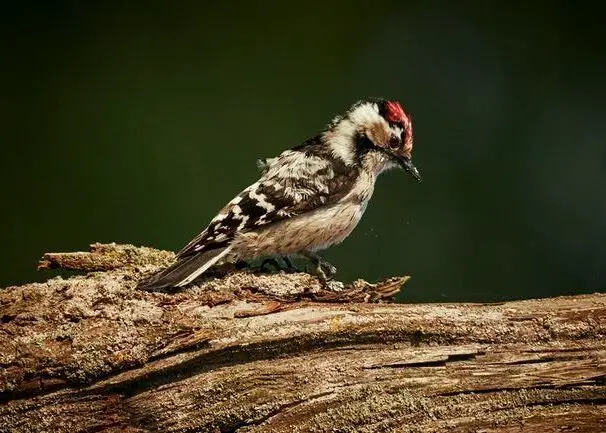
Scientific name: Dryobates nuttallii
Size: 6.3-7.1 inches
Weight: 1.1-1.6 ounces
Wingspan: 13-16 inches
Nutall’s woodpeckers only live in Southern California and Baja California in open woodlands with oaks, willows, and cottonwoods. Once in a while they will stray up to southern Oregon. Though it doesn’t have a large range, it’s common in the areas where it does live.
They’ve been known to visit suet feeders, though they’re much less common visitors than some other woodpeckers in California. Those who live in the suburbs of California should look up at oaks as they walk by and they might be lucky enough to see one.
The males tend to hang out on the trunk and larger branches to feed, while the females stick to smaller branches and twigs.
These diminutive woodpeckers are white and black, so they look similar to some of their related species. You can differentiate the males from the females by the bright red stripe on the back of the male’s heads. They have horizontal stripes on their back and two thin stripes on their cheeks. Juvenile birds have slightly gray feathers on their undersides.
Males excavate the nests in trees and the females lay their eggs. Pairs tend to be monogamous and stick together for years.
Nuttall’s Woodpecker Sound (Song)
6. Acorn Woodpecker

Scientific name: Melanerpes formicivorus
Size: 7.5-9 inches
Weight: 2.3-3.2 ounces
Wingspan: 14-17 inches
Acorn woodpeckers are often described as having the face of a clown because they have a black mouth surrounded by a white border and black over their eyes. They have a red cap, a black body, and a white patch on the rear and on each wing. The chest is slightly gray or white.
These woodpeckers live in evergreen forests on the west coast and in a few parts of the southwest. These birds collect acorns and fill holes in trees full of the collected nuts. These caches of nuts can be used by generations of woodpeckers and one tree may contain up to 50,000 holes.
In addition to acorns, they also eat insects, especially ants, as well as seeds, nuts and sometimes the eggs of other birds.
This is one of the few species that prefers to live in small colonies rather than alone, and studies reveal that they do this to help one another raise young, a practice called cooperative breeding.
Acorn Woodpecker Sound (Song)
7. White-Headed Woodpecker

Scientific name: Dryobates albolarvatus
Size: 8.3-9.1 inches
Weight: 1.9-2.3 ounces
Wingspan: 16-17 inches
These unusual woodpeckers only live in central Northern and Southern California and the Pacific Northwest in pine forests. They eat pine nuts as well as insects that they find under the bark of the tree.
They don’t typically peck holes into the wood as other woodpeckers do. Instead, they peel and pull off the bark of trees to look for bugs hiding underneath.
They are black with a white head and white patches on the undersides of the wings. The males have a red cap. They’re the only woodpecker in North America with a solid black body and solid white head, which makes them easy to identify.
They typically choose to flock in pairs or in small groups made up of related birds.
White-Headed Woodpecker Sound (Call)
8. Red-Breasted Sapsucker
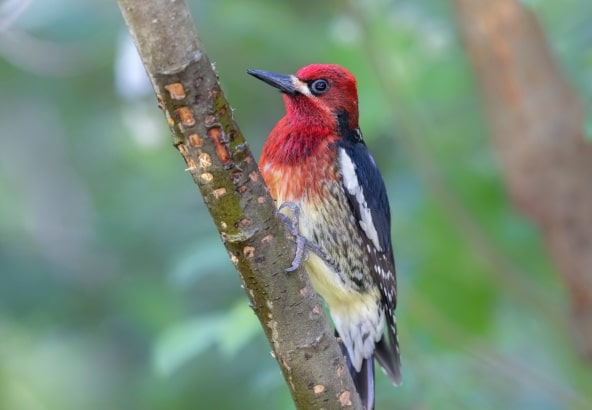
Scientific name: Sphyrapicus ruber
Size: 7.9-8.7 inches
Weight: 1.9-2.2 ounces
Wingspan: 14.5-16 inches
These woodpeckers live on the west coast of the US, migrating from Canada to parts of Northern California in the winter. Others live year-round in Southern California.
They have brush-like tongues that they use to lap up sap that they access by pecking little holes in the wood of trees. They’ll also eat the soft green layer of wood underneath the bark. They also eat berries and fruit and will visit suet feeders.
The adults have a red head and chest, with a black back and mottled grey and black chest. Juveniles lack the red head and chest and have an overall brown hue.
They’re related to Red-naped sapsuckers, and for a while, scientists thought they were the same species. Scientists have determined that these birds prefer old-growth forests and that populations might be reduced as old-growth forests are cut down.
Red-Breasted Sapsucker Sound (Call)
9. Ladder-Backed Woodpecker
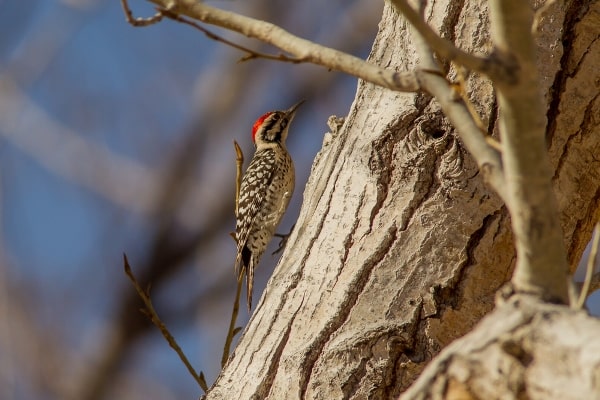
Scientific name: Dryobates scalaris
Size: 6.3-7.1 inches
Weight: 0.7-1.7 ounces
Wingspan: 13 inches
Across the arid desert of the southwestern US live the Ladder-backed woodpecker. These tiny foragers flit among the cacti to find food, and they’ll also visit feeders that have mealworms or black oil sunflower seeds.
They’re black and white with white bars across the wings and back that look very much like a ladder. The chest is spotted black and white. The males have a red crown.
While other woodpecker species that make their home in the desert need large plants to make a nest in, these petite little birds can live in the scrub and shrubs. They’re a close relative of the Nutall’s woodpecker.
Ladder-Backed Woodpecker Sound (Call, Rattle Call)
10. Lewis’s Woodpecker

Scientific name: Melanerpes lewis
Size: 10.2-11 inches
Weight: 3.1-4.9 ounces
Wingspan: 19-.20.5 inches
This medium-sized bird lives across the western half of the US, migrating from the northern part of the country to the southern part during the winter. They don’t dig or peck into the wood, but find insects crawling around on the bark.
These pretty woodpeckers are green and pink with a red face and white neck, which makes them stand out among other species. It also likes to catch insects mid-air while they’re flying, which sets it apart from other birds. That’s something most woodpeckers don’t do, for the most part.
As fall comes around, this industrious bird collects acorns and other nuts and stuffs them into cavities in trees so that they have food for later.
Pairs mate for life and make nests in excavated trees or utility poles.
Lewis’s Woodpecker Sound (Call – Male)
11. Williamson’s Sapsucker

Scientific name: Sphyrapicus thyroideus
Size: 8.3-9.8 inches
Weight: 1.6-1.9 ounces
Wingspan: 17 inches
Like other sapsuckers, this one drills small holes into trees. Then they wait for the sap to start leaking out and they drink it. They also eat ants and other small insects.
They prefer coniferous forests and they live in the mountains of western North America. They spend their time in the higher elevation forests and drop down to lower elevations during the winter. However, in the 1990s, scientists found that this sapsucker had extended its range as far south as Baja California.
Large for a sapsucker, the males are mostly black with a yellow belly, They have white patches on the wings and a red chin and throat.
The females have horizontal white barring on their backs. They also have a brown head with a variably yellow belly. The sexes appear so different from one another that scientists originally thought that they were different species.
The males carve out holes in trees to create a nest for the female to lay her eggs in.
Williamson’s Sapsucker Sound (Call – Male)
12. Red-naped Sapsucker
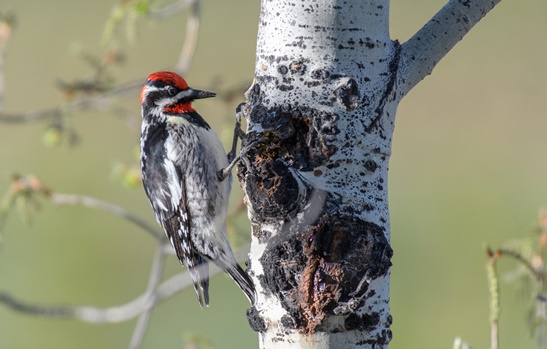
Scientific name: Sphyrapicus nuchalis
Size: 7.5-8.3
Weight: 1.1-2.3 ounces
Wingspan: 16-16.9 inches
As the name suggests, this bird has a thing for the sap in trees. It will tap little holes into the bark so that sugary sap runs out and it can eat it. They particularly love aspen, pine, and birch trees. They’ll even nest in backyards that have those trees, and they will stop and visit if you provide them with a suet feeder.
These sapsuckers have vertical white patches that you can only see when the wing is folded. They have black and white striped bodies and heads, and a bright red cap and throat, though some females have a white throat.
This is a close relative of the red-bellied sapsucker and the yellow-bellied sapsucker. They all look fairly similar.
Red-naped Sapsucker Sound (Call, Alarm Call)
13. Gila Woodpecker

Scientific name: Melanerpes uropygialis
Size: 8.7-9.4 inches
Weight: 1.8-2.8 ounces
Wingspan: 15.8-16.5 inches
In Southern California, Arizona, and a small section of New Mexico lives the Gila woodpecker. These woodpeckers make its home in the arid deserts of southern North America where it makes its nest in dead trees or living saguaro cacti. They eat insects and fruit, and they’ll also nibble on nuts and seeds in backyard feeders.
These birds have a tan head and belly and black and white striped wings. Males have a red crown, but females and juveniles do not. They’re very territorial and will chase off swallows, wrens, and European starlings.
Gila Woodpecker Sound (Alarm Call)
14. Black-backed Woodpecker

Scientific name: Picoides arcticus
Size: 9.1 inches
Weight: 2.1-3.1 ounces
Wingspan: 15.8-16.5 inches
Many woodpeckers in California and the rest of North America are some pattern of black and white, often with a red patch on the head. This woodpecker stands out because of its solid black back and white chest. It has a black face with a distinct white stripe. The male has a small yellow crown.
Making its home in burned-out forests across Canada and the western US, its black coloring helps it blend in with the charred trees that it hunts on. It eats beetle larvae and will hang out in recently-burned areas for several years before moving onto more newly burned areas.
Black-backed Woodpecker Sound (
15. Gilded Flicker
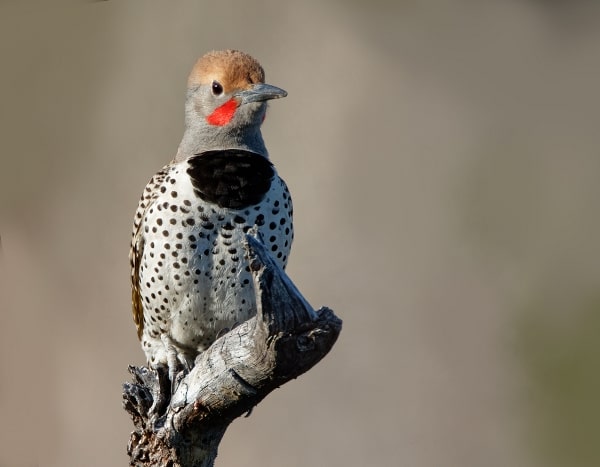
Scientific name: Colaptes chrysoides
Size: 11 inches
Weight: 3.3-4.5 ounces
Wingspan: 19.7-20.5 inches
The gilded flicker only lives in the tip of Southern California and the southern half of Arizona, as well as Northern Mexico. They make their homes in the Sonoran desert in Mexican giant cardon cacti and giant saguaros.
They look similar to their close relative, the Northern flicker, with a gray body, black and tan wings, and black spots on the belly. Males have red cheeks and both sexes have a tan crown on a gray head. Both have a large black crescent on their chest and yellow underwings.
Even though they live in holes that they make in cacti, they don’t feed on plants. Instead, they dig for ants in the ground.
Suggested Articles: Owls in California Hummingbirds in California

Terrific posting!! Photos and bonus of the sounds of the various woodpeckers is really great and helpful, thank you so much!